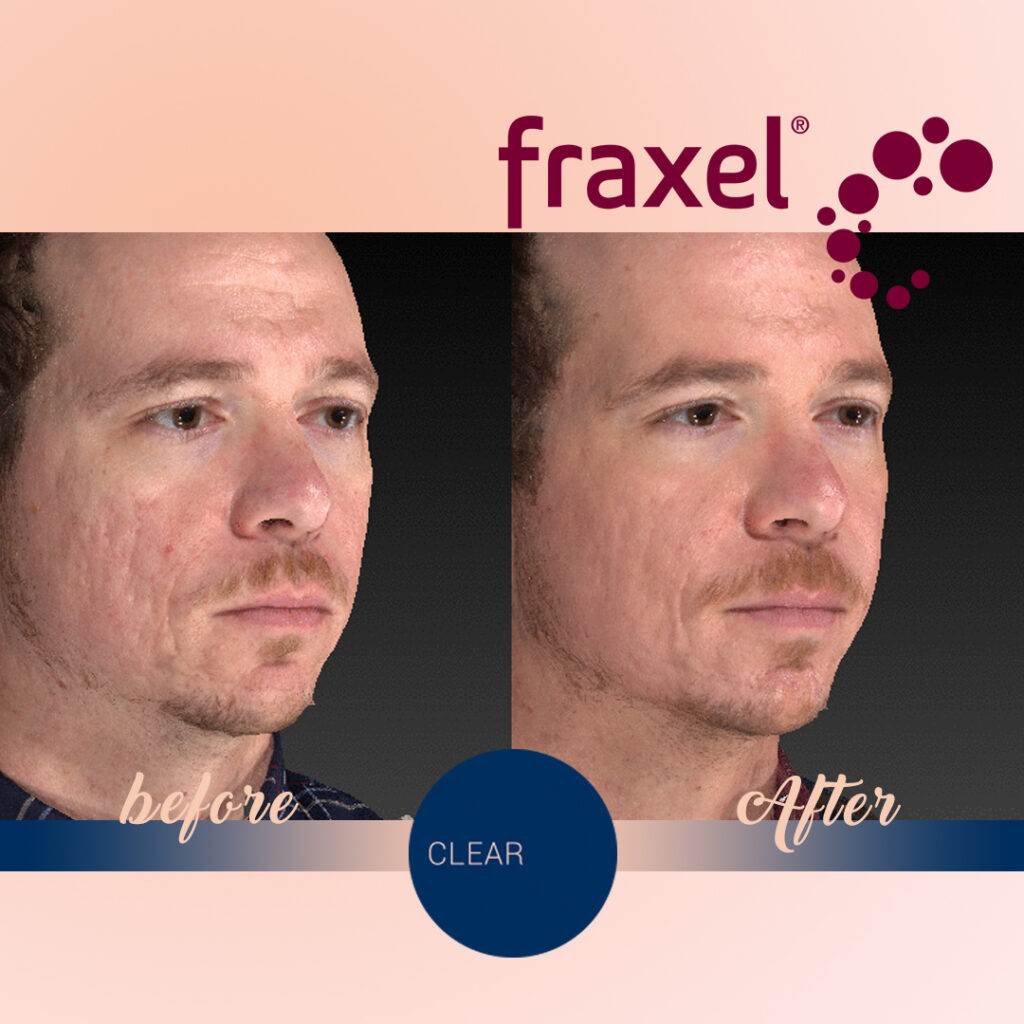Here’s What Your Skin Looks Like After Fraxel Treatments

Miracle cure or celebrity hype?
From Chelsea Handler’s before and after to Charlize Theron’s appearance on the red carpet, there’s one thing on many of our minds: Are those photos real?
Whether it’s the wrinkle disappearing act or leftover imprints of a treatment, Fraxel laser has gained attention with celebrities swearing by the rejuvenating effects. And the before-and-after photos seem downright compelling.
Fraxel comes from treating a “fraction” of the skin, explains Dr. David Shafer of Shafer Plastic Surgery & Laser Center in New York City.
Since the treatment leaves the surrounding tissue intact, it gives Shafer’s patients “a matrix of treated skin next to untreated skin, [resulting in healing] much faster with less downtime but still achieving excellent results.”
While it might seem like erasing decades from your face is just a laser treatment and credit card bill away (cost can range from $500 to $5,000), there are a few things you should know about Fraxel.
How far does Fraxel’s ‘magic’ extend?
According toDr. Estee Williams, board-certified dermatologist in New York City, Fraxel-type laser treatments are ideal for anyone ages 25 to 60 who want to improve skin texture and resurface skin texture to:
- soften fine lines
- lessenacne scars(icepick, boxcar, post-acne hyperpigmentation)
- heal traumatic scars (surgical scars, injury, burns)
- address texture issues
- lightenage spotsand brownsunspots
- balance uneven skin tone
- reducestretch marks
But it has limits. Not only are there different devices, each device has different settings.
These variations can affect treatment outcomes as well as cost. However, technicians may also be able to use different settings on different areas, offering a patchwork treatment for the best results.
If you have sensitive skin or active skin issues such as eczema, acne, or moderate to severe rosacea, Williams warns you may not be a good candidate for Fraxel-type resurfacing.
People with dark skin tones and melanin may want to avoid aggressive-type lasers as they can cause pigmentation issues. However, if you’re patient with the gentler lasers, you can still reap great results.
If you’re looking for serious and fast results, particularly for scarring and etched-in wrinkles, be prepared for a recovery time commitment. Getting a Fraxel treatment won’t always fit during your lunch break.
Fraxel’s magic relies on creating micro-injuries on your skin
In short: It hurts your face, but in a good way.
“Fractional” lasers create these micro-injuries that form a grid light pattern because the laser beam is split into many small beams.
With these targeted micro-injuries, you can trigger a healing reaction without damaging your skin. Likemicroneedlinganddermarolling, Fraxel is a call to your body, telling it to generate new collagen directly to a specific area.
Keep in mind that not all lasers injure equally or require the same amount of downtime. Dr. Deanne Mraz Robinson, assistant clinical professor of dermatology at Yale New Haven Hospital, tells us there are two general types of fractional resurfacing:
- ablative: more aggressive treatment that requires longer downtime and aftercare as it removes layers of tissue on the skin’s surface and stimulates collagen below the surface
- non-ablative: less aggressive treatment that has smaller results and shorter downtime as it doesn’t remove surface tissue
Is it safe?
While Mraz Robinson confirms Fraxel’s long history of safety, she also warns that your safety lies in the hands of your provider — and sometimes yourself.
If you don’t follow (or receive) instructions for aftercare, you may end up in more trouble than when you started. Especially if you’re doing ablative resurfacing, which requires waiting for a period of skin regrowth.
“Sometimes it’s better to do multiple treatments on lower settings with less downtime and less risk than doing fewer treatments on higher, more intense settings with more downtime and risk,” recommends Dr. Shafer.
Mraz Robinson also adds: “If someone has a history of keloidal or hypertrophic scarring or vitiligo, Fraxel is generally not suggested as it can worsen these conditions.” People with dark skin are often at higher risk for developing keloids (excess scarring from collagen overproduction).
Fraxel’s range from $500 to $5,000, depending on where you live
While the cost varies depending on your region, what type of treatment, and the number of sessions needed, you could be looking at an average of $500 to $5,000 per treatment, advises Shafer. The average cost in NYC, according to Williams, is $1,500.
Don’t bank on your insurance covering it, unless it’s deemed medically necessary. Some of Shafer’s patients “have been successful in claiming coverage with their benefits,” but be prepared to pay out of pocket for your treatments.
Yep, as you consider the cost, remember you’ll need multiple treatments, and that different types of Fraxel treatments can vary in price as well.
Ask your provider which Fraxel treatment works for you
There are a dizzying array of fractional laser types, from what Shafer dubs the “baby Fraxels” such as Clear + Brilliant favored by celebrities like Drew Barrymore, to the intense Fraxel Repair with weeks of recovery downtime.
Shafer, Mraz Robinson, and Williams use a range of fractional lasers on their patients, including:
- Clear + Brilliant
- Palomar IKON
- Sublative Fractional RF
- C02 Fractional
- Pico Way Resolve 3-D Holographic Fractional
- Ulthera
- Fraxel Restore
- Fraxel Dual
- Fraxel Repair
With so many options, how do you choose? Work with a qualified provider, such as a board-certified dermatologist or plastic surgeon, to find the right type of fractional laser for your skin and recovery needs. Let them know your desired results and downtime and your provider will balance your expectations and help find a treatment that helps achieve your dream results.
You’re also going to need more sessions than you think
“[A] real problem for the ‘Fraxel’ brand as a whole is this idea that patients can do one treatment and be finished,” says Shafer. Fraxel-type lasers are only treating 25 to 40 percent of the area at a time. “It only stands to reason that multiple treatments are necessary.”
He considers setting realistic expectations essential for providers to avoid disappointing results.
“Some patients come in who had previous Fraxel treatments at other offices and tell me they didn’t like their results,” explains Shafer. “When I ask, they say they did only one treatment.”
Should you only get Fraxel-branded treatment?
While it’s not the only laser resurfacing game in town (non-Fraxels use one wide beam), fractional laser technology has established itself as the new gold standard for laser treatments, according to Shafer*. “[They offer] a brand recognition we understand to imply luxury, quality, and results like that of Tiffany, Ferrari, and Apple.”
But if your favorite trusted provider doesn’t offer Fraxel, don’t despair: it’s all in a name.
“Fraxel is a brand name, like Kleenex or Botox,” says Mraz Robinson. “[The Fraxel name] denotes fractional laser resurfacing.”
Even Shafer’s patients use the term Fraxel “interchangeably with many brand-name specific lasers,” but it’s the fractional technology, rather than the Fraxel brand name, that matters.
*With contributions throughout from Graceanne Svendsen, certified laser technician.

FORT LEE, NJ
1640 Schlosser Street Suite C-3
Fort Lee, NJ 07024
CONTACT: 201-944-0808
contact@clearlaserskin.com


Manhattan, NY
501 5th Ave Suite 1601
New York, NY 10017
CONTACT: 212-697-1802
contact@clearlasercity.com


QUEENS, NY
210-16 Northern Blvd. #2A Bayside, NY 11361
CONTACT: 718-224-1720
contact@clearlaserqueens.com


JERSEY CITY, NJ
106 River Drive South Suite 2,
Jersey City, NJ 07310
CONTACT: 814-830-3581
contact@clearlaserjc.com


The information on this website, including articles authored by healthcare professionals, is for general information purposes only, does not constitute medical advice and is not intended to be relied upon for medical diagnosis or treatment. If you are experiencing an emergency, contact 911 or contact a medical provider immediately. Consistent with Clear Laser Skin Clinic website privacy policy, Clear Laser Skin Clinic is not responsible for the privacy practices or the content found at links to other websites.
- 2023 © Clear Laser Skin Clinic. All rights reserved | Powered by MOBIWEBI INC.

Leave a Reply